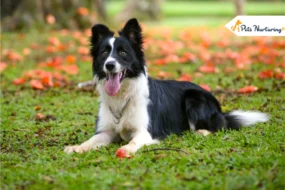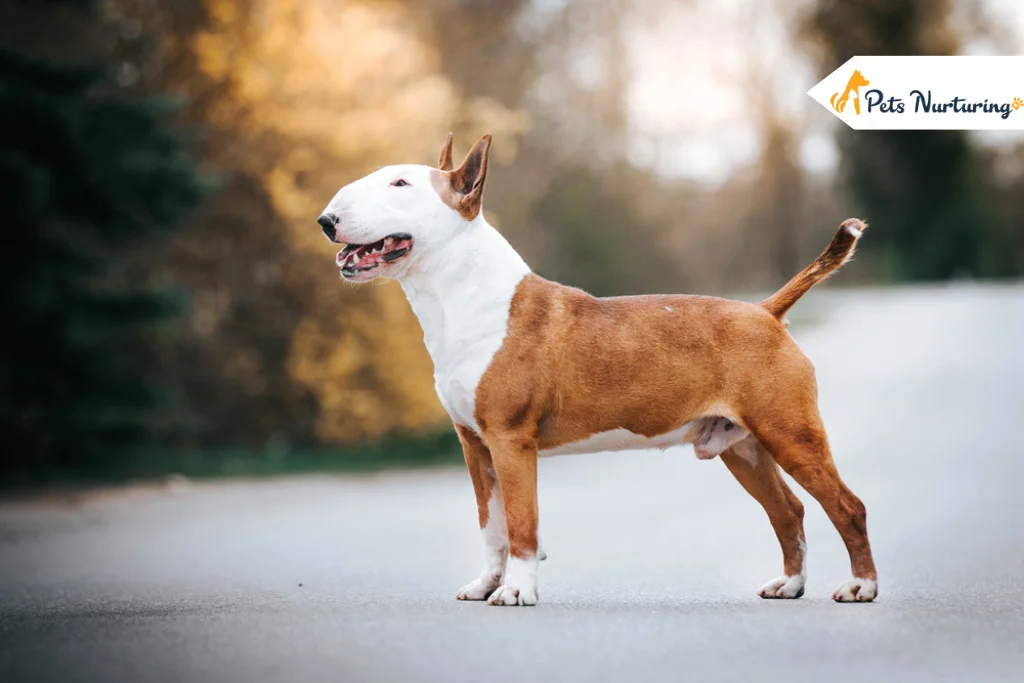
Bull Terrier Dog are friendly, loyal, and playful dogs. They have a distinct appearance and can easily adapt to various living conditions. Remember those fun Budweiser ads with Spuds Mackenzie – the Bully with a cool grin? Well, those commercials made Bull Terriers extremely popular.
Pam Nichols, DVM, president of the American Animal Hospital Association, describes Bull Terriers as adorable clown dogs. They are very funny but love being with people. Living with a Bully is always exciting. They’re lively from puppyhood to middle age. They don’t like being alone for too long and prefer always being busy.
These dogs are best for families who can play a lot with them. Also, they need someone who gently teaches them rules, or they’ll make up their own. While they might not be as cute as other dogs, they make good companions. Life with them will never be boring!
If you want to know more about Bull Terrier dog breeds, continue reading.
Breed Overview
The Bull Terrier is a medium-large dog from England. They have a short, smooth coat and a special egg-shaped head.
Originally, Bullies were bred for dog fights, but now they have become great companion dogs. They’re fun and full of energy, sometimes goofy and a bit stubborn.
People often call them a “kid dressed as a dog.” Bull Terriers shine as show dogs and are famous as the “Target dog,” the mascot of the company.
Want to know more about their history, characteristics, and care? Keep reading!
Bull Terrier Dog overview
Breed Group: Terrier
Height: 21 to 22 inches
Weight: 50 to 70 pounds
Lifespan: 10 to 14 years
Coat: Short and smooth
Color: Various (Red, Black, White, Fawn, Blue, etc.)
Temperament: Energetic, playful, sometimes stubborn
Grooming Needs: Low maintenance, regular brushing, occasional bathing
Hypoallergenic: No
Origin: England
History
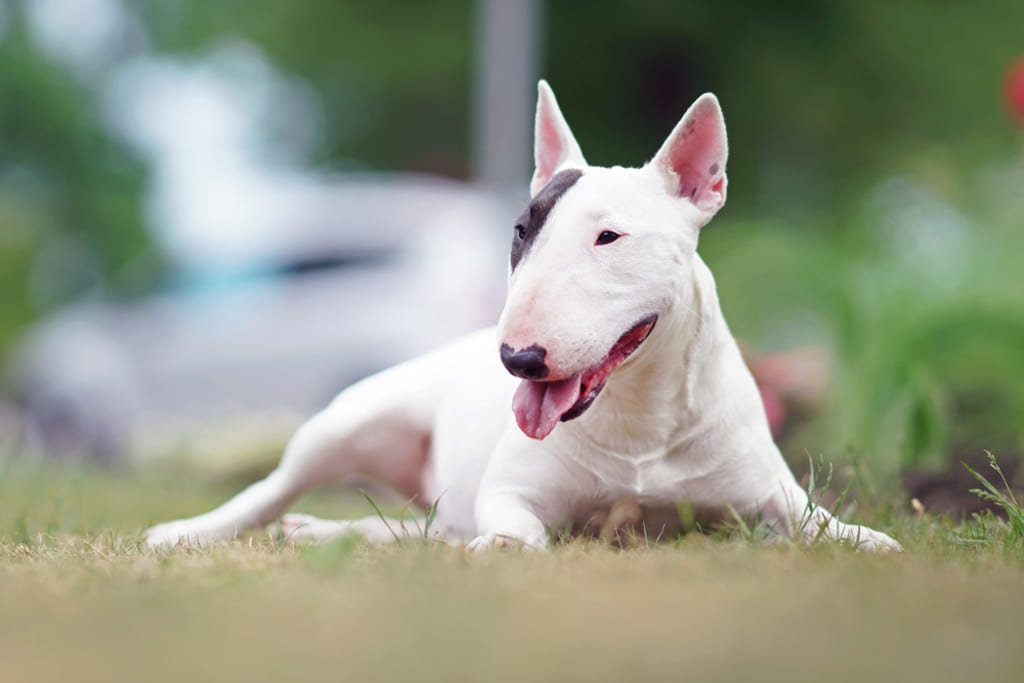
Around the 13th century in Britain, cruel animal blood sports became a thing. One popular sport was bull-baiting, where a bulldog fought a tied-up bull while people bet on the winner.
But in the 1800s, these gruesome sports were banned. Sneaky people still did dogfighting, though. Instead of bulldogs, they wanted more agile dogs, so they mixed Old English Bulldogs and Terriers. That’s how breeds like the Bull Terrier came to be.
People thought mixing Bulldogs with Terriers would make better fighters. But they didn’t care much about keeping the breed the same.
Later on, a man named James Hinks crossed these dogs with English White Terriers to create a nicer look with short legs and a better head. The first ones didn’t have the distinct “egg face” we see today.
As dogfighting faded out by the mid-1800s, breeders changed the Bull Terrier to be more of a buddy than a fighter. They aimed for a nicer personality and a less tough look. It took a while, but eventually, they got that famous curved head. In 1885, the American Kennel Club finally recognized the Bull Terrier as a dog breed.
People loved these dogs, and breeders kept mixing them with Dalmatians, Whippets, Pointers, Borzois, and Collies to make them more graceful. Hinks really wanted them all to be white.
But breeding them all white caused health issues. So, some breeders, like Ted Lyon, started adding color by introducing Staffordshire Bull Terriers. The AKC acknowledged Colored Bullies as a distinct variety in 1936.
President Theodore Roosevelt was a proud owner of a Bull Terrier. These dogs even became stars in commercials for Bud Light and Target.
Appearance
The Bull Terrier dog is known for its head, which is shaped like an egg when you look at it straight on. The top of their skull and face is almost flat, curving down gently to their nose. They have a black nose which bends down a bit at the tip. Their nostrils are well-shaped with pointy ears. Their lower jaw is sturdy and deep.
What really stands out are their unique, triangular eyes. They’re small, dark, and set deep into their face. They’re the only registered breed with eyes shaped like triangles. Their body is solid and round, with strong, muscular shoulders. They carry their tail straight out, horizontally.
When it comes to size, it can vary a lot. Some dogs are small, around 35 pounds, while healthier males can reach 75 pounds. There are even miniature Bull Terriers, a separate breed since the ’90s, weighing less than 30 pounds.
Height: 21 to 22 inches
Weight: 50 to 70 pounds
Coat and Color

Bullies have a sleek, short coat that’s shiny and feels tough. They have two color types: white and colored. You can find them in 20 different color combos and markings.
White ones are entirely white, maybe with some colored markings on their head but nowhere else on their body. If you are looking for white dog breeds, go for a Bull Terrier.
Colored Bullies can be any color except white or have white markings along with their main color.
Here are some common coat colors:
- White
- Fawn
- Red
- Black
- Blue
- Brindle
Characteristics and Temperament
Bull Terriers may look tough, but they’re actually sweet and gentle. They’re like the funny kids in the dog world, always making their owners laugh. They’re playful and sometimes get up to mischief.
Because they’re spirited, they can be a handful. They might get a bit jealous if they feel left out. Sometimes, they develop habits like pacing or chasing their tail or shadow. If you see these behaviors a lot, it’s good to talk with your vet.
These dogs love being with you and might do best with someone who knows about dogs. They’re friendly not only with you but also with strangers.
Bullies can be a bit independent and stubborn, which might not suit someone new to dogs. But with proper training, they’re pretty chill. They’re described as good with people, even though they can be a tad headstrong.
Early socializing helps them get along with other animals and dogs. Their personality is brave and lively, and they’re all about having a good time.
“Socialized Bull Terriers are social butterflies,” says Sarah Wooten, DVM, veterinary expert for Pumpkin Pet Insurance. “They adore meeting new people and showing them lots of love.”
They’re great with kids and make awesome family pets. Even though they’ve been targeted by some laws, a study found they’re not significantly different in temperament from Golden Retrievers.
Health and Nutrition
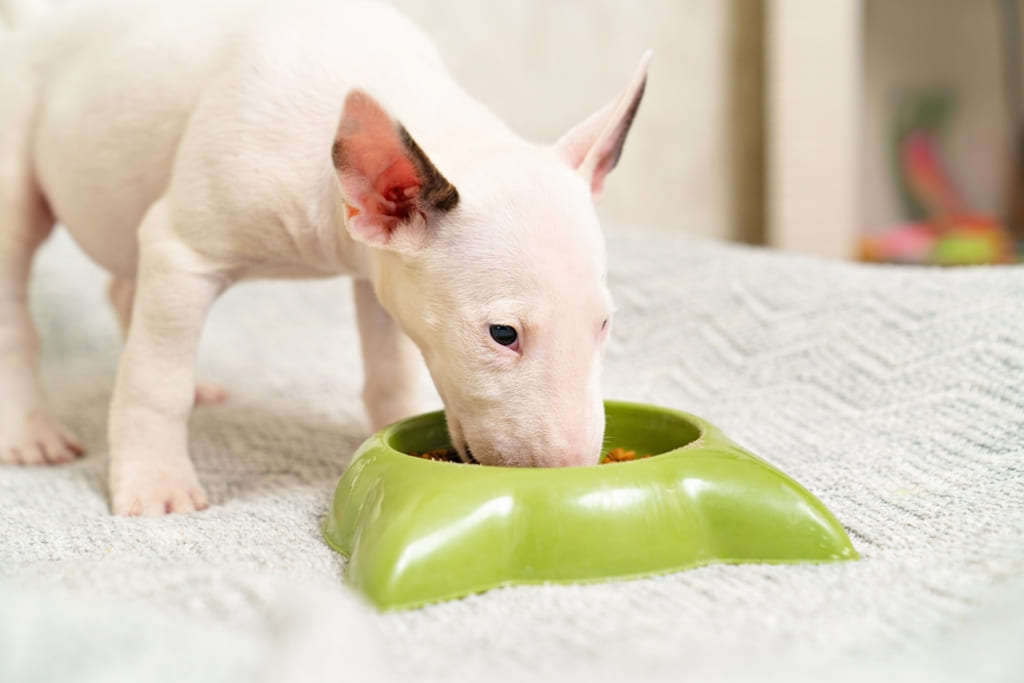
To keep your Bully healthy, give them high-quality dog food approved by the AAFCO for proper nutrition. Stick to trusted brands like Royal Canin, Purina, or Hill’s Science Diet, which are recommended by vet nutritionists.
Dr. Yui Shapard, Educational Director for the Association of Asian Veterinary Medical Professionals, notes, “These three pet food brands have board-certified veterinary nutritionists who test, monitor, and oversee the nutritional standards for both prescription and non-prescription diets.”
Feed your Bully measured portions of food suitable for their age twice a day. Don’t leave food out all the time to avoid them getting obese.
Follow the feeding guidelines on the food label, usually between 1⅝ to 4¼ cups per day, based on their age and size. Be cautious not to overfeed, even though they’re active and love eating.
For Bull Terrier puppies, ensure they get enough natural calcium for proper bone development. If their food doesn’t cover it, talk to your vet about calcium-rich foods or supplements. Also, always have fresh water ready for your dog.
Common Health Problems
According to the Bull Terrier Club of America, Bullies generally live around 12-13 years but can face some health issues. They tend to chew on things, risking intestinal blockages and sometimes needing surgery. Here are some common health problems:
1. Patellar Luxation
They might experience patellar luxation, seen when they lift a hind leg suddenly or yelp. Mild cases might not need treatment, but severe cases may require surgery or supplements for joint health.
2. Hereditary Nephritis
Hereditary nephritis is a kidney issue that can lead to kidney failure. Symptoms include appetite changes and increased thirst. Sadly, by the time it’s diagnosed, treatment might not work well.
3. Mitral Valve Dysplasia
It is a heart issue that can cause coughing, tiredness, or fainting. Although there is no cure, treatments like oxygen therapy or medication help manage symptoms.
4. Partial or Total Deafness
Some Bullies might be born deaf due to certain genes. Testing or observing their responses to sounds can diagnose this. Sadly, there’s no treatment, and deaf dogs shouldn’t be bred, but they can live happily with adjustments in training.
Behavior and Training
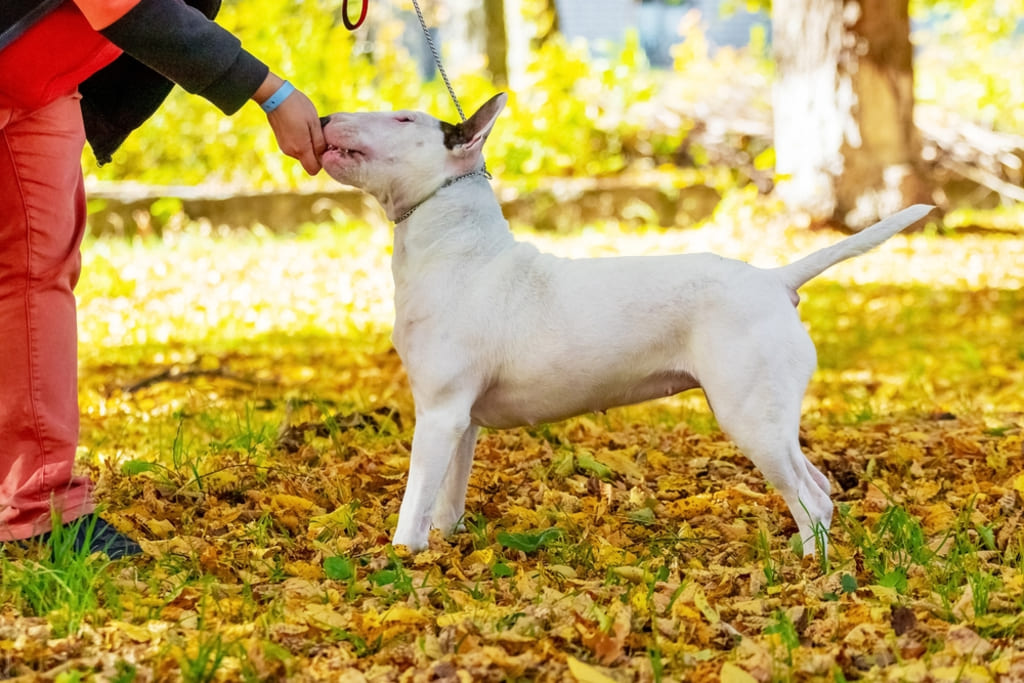
The Bully is a playful, lively dog, often compared to a 3-year-old in a dog’s body. They’re loving but don’t reserve all their affection for just their family—they’ll gladly cozy up to anyone offering treats or cuddles.
But sometimes, they might want their own space, and they can switch moods quickly. While they’re affectionate with family, they might not always get along with other pets. Training and socializing them early and regularly is important. It’s wise to supervise them around small kids.
Training these dogs isn’t a walk in the park, but they’re smart and can learn a lot if you make it fun and consistent. They might not get it right away, but it’s more about motivation than intelligence. Treats and toys are great rewards, but watch their weight with too many treats!
Kim Bebb, president of the Bull Terrier Club of America, mentions, “Bull Terriers are always up for exercise and love starting each day fresh. Being part of the family is what they thrive on.”
Here are some fun activities to keep them happy:
- Nose work/tracking
- Agility
- Fast CAT (a timed 100-yard dash competition)
- Obedience training
Exercise Needs
Make sure your Bully gets one to two hours of exercise daily to burn off their high energy. Take them for several walks, play fetch, go on jogs or hikes, and engage them in games. Puzzle toys are great for mental stimulation, and activities like agility or tracking can keep them both physically and mentally active.
When outside, always leash your Bully or keep them in a secure fenced area. Not all Bullies are friendly with unfamiliar dogs. Also, remember their short coat doesn’t protect them well in cold weather, so limit outdoor time in the cold and consider a coat or sweater for them.
Grooming Needs
Grooming your Bully is very easy due to their short coats and generally healthy ears and eyes.
1. Skin Care
Some Bullies might develop itchy skin due to allergies, especially on their feet, belly, or ears. Treating the cause is best, but if not possible, your vet might recommend medicated baths or oral medications to ease discomfort.
2. Coat Care
Though they shed quite a bit, a soft-bristled brush once a week usually keeps their coat in check. Baths are rarely needed as they tend to shake off most dirt on their own.
3. Eye Care
Bullies usually don’t need special eye care except for the possibility of dry eyes as they age.
4. Ear Care
Regular ear cleaning is often enough for Bullies, as they’re less prone to ear infections. However, especially for whfite puppies, a hearing test is recommended due to potential hereditary deafness.
5. Dental Health
Aim to brush their teeth every day to avoid any dental problems. It will keep their teeth and gums healthy.
6. Nail Trim
Trim their nails once or twice a month. Short nails will make sure that they don’t get caught up in the carpet or break while they are running.
Are Bull Terriers Hypoallergenic?
Bullies might shed less and produce less allergy-triggering dander compared to some breeds, but they aren’t classified as hypoallergenic by the AKC.
So, if you’re considering a Bully or a mix, it’s important to find out if they trigger your allergies. Visit a breeder and spend some time with a Bully to see if you are allergic to them.
If you have already bought a Bully home, invest in a good vacuum for pet hair to keep your home clean and prevent any allergies.
Price
Bull Terrier puppies for sale from a good breeder usually range from $1,800 to $3,000 on average.
The price can differ based on various factors like the pup’s age, quality, gender, family history, and where the breeder is located.
Bebb, a breeder and expert since 1983, suggests that well-bred Bull Terrier puppies for sale with guaranteed health and temperament might cost up to $3,000.
For those considering Bully rescue instead of buying from a breeder, the Rescue Welfare Trust Fund of the Bull Terrier Club of America provides valuable assistance and resources.
Life Span
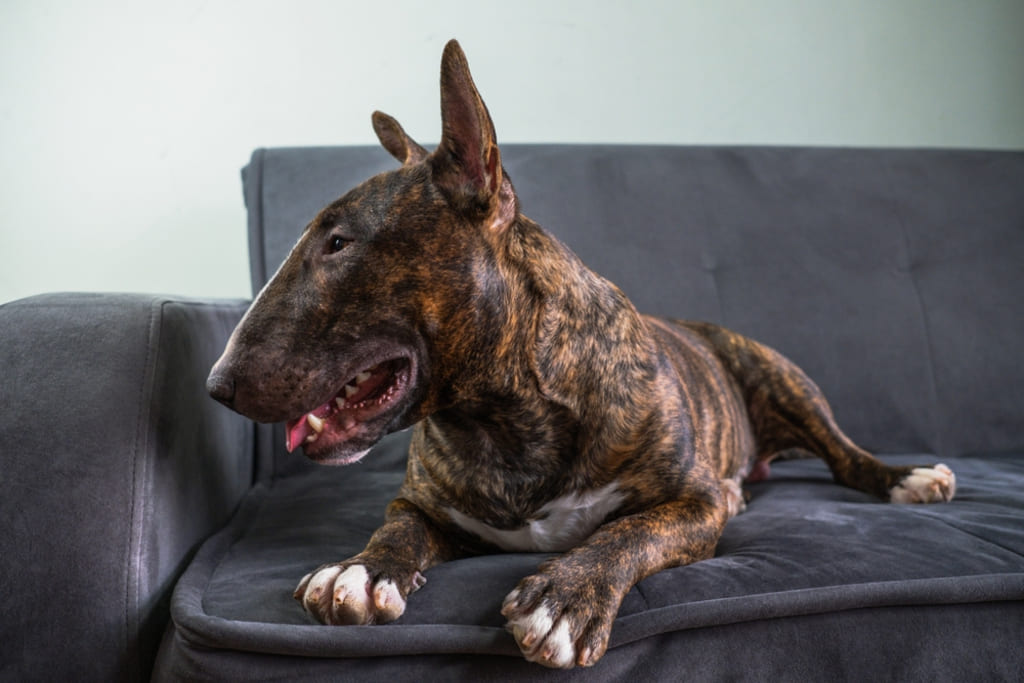
A healthy Bully can live up to 14 years with proper care and activity. They slightly surpass the average lifespan of most medium-sized dogs, which is typically 10–13 years.
However, Bullies are prone to various health issues, including hereditary nephritis, leading to kidney failure. Symptoms like reduced appetite but increased thirst and frequent urination indicate this condition.
So, it’s crucial to adopt from reputable breeders, ensuring healthy kidney function in pups to avoid potential complications later on. Early detection is key to managing this condition effectively.
FAQs
Bullies are generally sweet and well-behaved, but sometimes they may become aggressive around other male dogs.
Go to the internet and search online for Bull Terrier for sale to find the nearest breeder.
Bullies have an estimated bite force of approximately 305 pounds per square inch (psi.
Yes, Bullies make excellent guard dogs and will protect you from any impending danger.
Conclusion
That’s all you need to know about Bull Terrier dog breeds if you are considering buying one. They look different than most dogs because of their unique head shape, but that’s what makes them special.
Despite being bred as a fighting dog, they make pretty good family dogs. The best thing about a Bully is that they can easily adjust to any living situation if you provide them with proper training and exercise.
They are playful, gentle, loving, and the ultimate comic champ. If you are having a dull day, simply spending a few minutes with them will brighten your smile.
However, remember to choose a reputable breeder when buying any dog. It will help you prevent any genetic disorders and ensure your dog grows to its full age.
Explore Further:










